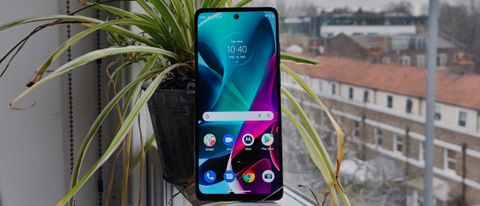TechRadar Verdict
The Moto G200 is a beast - it’s big, with a giant FHD+ 144Hz screen, and has loads of processing power, making it great for playing games and watching movies. It’s not going to be suitable for all users though, as the size makes it hard to use one-handed, and there are some rough edges in the photography and charging departments, too.
Pros
- +
Lots of processing power
- +
Responsive fingerprint scanner
- +
Hardy design
Cons
- -
Screen is only LCD
- -
Slow to charge
- -
Not suited to one-handed use
Why you can trust TechRadar
Two-minute review
The Moto G200 is the logical endpoint of Motorola’s recent push to offer low-cost smartphones with top-end specs, and as such, it’s one of the best phones we’ve seen from the company.
The Moto G series has always been characterized by affordable mobiles with competitive specs, but in the last 18 months the company made a more concerted effort to build smartphones that more closely rival premium mobiles like iPhones and Samsung Galaxy devices in terms of features and power. The Moto G200 is the most successful model yet in that spirit.
Sitting at the top of the Moto G family, the G200 offers a giant good-looking screen, a powerful processor and a high-res main camera. To many, it’ll feel similar to many other top-end flagships - except that it costs about half as much.
Ostensibly a successor to the Moto G100, but arguably more similar to the Edge 20 Lite, this phone is cementing Motorola as a big player in the mid-range phone market, ready to compete with the myriad Chinese brands which currently rule that roost.
The big draw is the phone’s speed - with the Snapdragon 888 Plus chipset, it’s super snappy for gaming or any other top-end function. This power combines well with the high refresh rate display in that regard, which also makes navigating the phone feel smooth.
The display is huge, though Motorola has never used the best-looking displays, as it generally opts for LCD over OLED. Still, thanks to its size and refresh rate it’s a great pick for people who like watching content or playing games on their smartphone.
The Moto G200 fixes lots of issues we had with the G100 and other previous Moto phones, and the best example is the side-mounted fingerprint scanner. This is really quick and intuitive to use this time round, which makes unlocking the mobile incredibly easy.
Photography has also seen a big boost, as the 108MP main camera brings noticeable boosts to low-light snaps, and some other software tricks like an improved Portrait mode make this the best Moto phone in terms of camera capability.
Despite some great improvements, we can’t give the Moto G200 full marks, and it’s largely for things that are common traits of Moto phones. It’s huge, which means it’s hard to use for people with smaller hands, and it also won’t impress people who like small, easily-pocketable mobiles.
It’s also slow to charge - at 33W it’s a relic in an age of speedy chargers, especially when the same-price Realmes, OnePluses and Xiaomis lap it.
But overall, this is a top Moto phone, and if you aren’t put off by the trademark features of the company’s phones it’s a must-buy. We’d especially recommend it to people who were considering Moto Edge 20 phones - this mobile has all the features but a much lower price than most of them.
Moto G200 price and availability
The Moto G200 was launched in November 2021 in the UK, and while it’s possible that it’ll also come to the US and Australia at some point, we can’t say for certain it will, since Motorola has a rather messy and scattered release pattern between regions.
In the UK, the phone costs £399 (roughly $540, AU$760) - there’s only one memory configuration, which is 8GB RAM and 128GB storage, though you can choose between blue or green versions of the device.
At that price, this isn’t technically the priciest Moto G phone, as the G100 cost £449 (around $620 or AU$810) but with a caveat - buying that device also gave you a stand and cable for the Ready For service (more on that later) which is why it was pricier. With the G200, you just get the mobile, so ignoring for a second the peripherals, this is spiritually the top-end Moto G phone.
The specs make the Moto G200 a rival to the $799 / £769 / AU$1,249 Samsung Galaxy S21, $729 / £629 (about AU$940) OnePlus 9 or $799 / £779 / AU$1,349 iPhone 13, especially with a bigger screen than all three and a more powerful chipset than the first two, so it’s a good value-for-money proposition.
Design
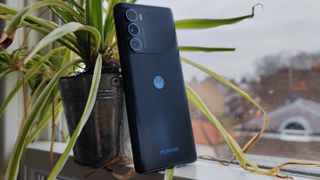
We can see the Moto G200 design being divisive, simply because it’s massive. With dimensions of 168.1 x 75.5 x 8.9mm, and a weight of 202g, you need pretty big hands for this to sit naturally in the palm.
In fact, we had a hard time using this one-handed, and we have average-sized mitts, so we recommend only buying this if you’re happy to use a mobile two-handed.
The main functional problem with its big size, other than the fact it can be hard to reach the extremities of the display, is that the side-mounted fingerprint scanner can be a stretch to reach when you want to unlock the phone. Thankfully, compared to previous Moto phones, having your fingerprint recognized is a lot more reliable and smooth - we found with the Moto G100, unlocking the thing felt like rolling a 20-sided dice to see if we were granted access, but that’s certainly not the case here.
Above the fingerprint scanner, on the right edge of the phone, is the volume rocker, and on the opposite edge is a small Google Assistant button (pressing this brings up the AI companion). We’re not sure how many people use this feature - we certainly don’t - but Moto has included it in enough phones at this point to suggest there’s definitely an audience for it.
There’s a USB-C port here, but no 3.5mm headphone jack - that isn’t too much of a shock, given many phone companies are ditching the port, but Motorola tends to be one of the companies that still uses it a lot.
The back of the Moto G200 is made of plastic, and it feels hardy enough to withstand a drop or two without shattering, unlike the glass used for many premium phones which is prone to smashing.
With an IP52 rating, the phone has limited water resistance and is mostly dust-resistant, but we wouldn’t recommend taking it for a swim or burying it in sand anyway.
Display

With a 6.8-inch display, the Moto G200 has as much screen space as the Samsung Galaxy S21 Ultra, which makes it perfect for people who like their streaming or gaming.
It’s not totally comparable with that phone, as its resolution is ‘just’ 1080 x 2460, or FHD+, but the vast majority of smartphones also are also FHD+.
There’s also a 144Hz refresh rate, which is above the competition as most other rivals use 120Hz, and it means motion looks very smooth. Refresh rate refers to how many times per second the display updates its image, and at 144Hz, everything from gaming to just scrolling through menus looks smoother.
Despite the decent resolution and quick refresh rate, some may turn their noses up at the Moto G200’s display as it uses LCD tech, not AMOLED or OLED which are generally seen as preferable for smartphones. As a result colors aren’t as vibrant and contrast isn’t as distinct as on the displays some rival phones beat, but it’s only a difference you’ll notice if you’ve experienced different types of screen tech.
We found the screen’s max brightness was a little dim too, but given how rarely you need a phone’s display as bright as it gets, this didn’t affect our day-to-day experience with the mobile.
Breaking up the display is a punch-hole cutout at the top-center of the front-facing camera, and due to the large size of the display, its relatively small size doesn’t take much real estate away.
Cameras
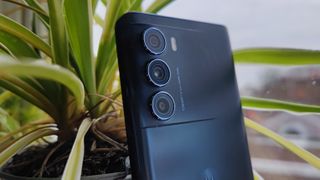
The camera collection on the Moto G200 is roughly comparable to that on the Moto G100, but with one big upgrade and another notable downgrade.
Firstly, there’s a super-high-res main camera, which this time is a 108MP f/1.9 snapper that’s a big resolution step up from the 64MP snapper on the G100. The phones share the same 2MP f/2.4 depth sensor and 16MP f/2.2 selfie snapper, but the G200 only gets an 8MP f/2.2 ultra-wide camera, down from 16MP for that same lens on the G100.
Pictures on the main camera looked bright and sharp, and while they could now and then look a little desaturated, that’s possibly the fault of the software as much as the hardware.
The benefit of a 108MP main camera, something Moto has already used in its Edge 20 series, is that it can do 9-in-1 ‘pixel binning’ - a technique where pixels combine to create fewer, larger ones that ‘see’ more light.
That doesn’t mean the Moto G200 is great at night photography, but it’s better than previous Moto phones, with less grain and also better exposure.
You can alternatively shoot in high-res mode, eschewing pixel binning for full-size snaps, and these can be better for people who like to edit photos in apps or on the computer, but this kind of file can eat up storage space quickly.

We had some trouble taking good pictures with the ultra-wide camera - that’s not because of the relatively low-res sensor, but rather in the lens department, as we found snaps could look a little distorted toward the edges.
Now onto selfies - these generally looked good, but Portrait mode could sometimes seem hit-and-miss, as though it nicely balanced the subject from the background when it worked, we often found it failed to accurately identify the subject in the first place. Our camera roll has a good few weirdly blurred selfies saved on it as a result, and we quickly learned to stick to standard photo mode for pictures on this camera.
Oddly, this wasn’t an issue we found with Portrait mode on the rear camera, and profile pictures often looked great.
Video recording goes up to an unnecessarily high-res 8K, same as a few other Snapdragon 888 phones, or up to 60fps but only at 4K. There’s some pretty robust video stabilization available if you record at lower resolutions, but these don’t work at 8K.
As with all Moto phones, and most other Android phones, the G200 offers a range of popular photography modes like Panorama, Pro, Portrait, document scanning and color isolation modes.
Camera samples







Performance and specs
One of the key Moto G200 selling points is its Snapdragon 888 Plus chipset, which was the most powerful processor used in Android phones when the Moto was announced, and it makes the phone more powerful than the likes of the OnePlus 9, Xiaomi Mi 11 or Realme GT (which all used the non-Plus version).
The chipset is paired with 8GB RAM and 128GB storage, and it has a 5G modem, making this phone compatible with next-gen networks.
When we put the phone through the Geekbench 5 benchmark test, it returned a multicore score of 3286, which is lower than we expected, given its chipset. It's exactly what the Samsung Galaxy S20 Ultra received, and falls quite far short of the 3500 or 3600 scores most Snapdragon 888 phones get.
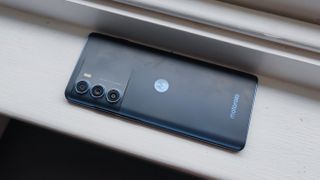
Numbers aside, we found the Moto G200 incredibly fast. Apps loaded in the blink of an eye, games ran their top graphics options without sweating, and we could easily fiddle about with complex camera modes and settings without the app having a meltdown.
This phone could be a godsend to mobile gamers on a budget as, between its top-end processor, 144Hz refresh rate and low cost, it’s great for gaming and undercuts most bespoke phones designed for the purpose. But even if you don’t spend your afternoons on Call of Duty Mobile or similar, this phone is both powerful and futureproof.
Software
The Moto G200 runs stock Android 11 - that means it’s as Google designed it, without the design and functionality tweaks lots of other companies make to the popular operating system. It’ll likely be eligible for a few years of updates, too.
Motorola does bring a few tweaks to Android though, and they’re useful ones. Our favorite are Moto actions, or quick gestures like twisting the phone twice to bring up the camera app, or doing two karate-chop motions to turn on the flashlight - these are really useful tools that speed up basic phone functions.
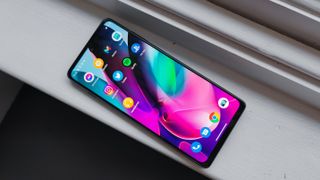
There’s also Moto’s Styles tool, which lets you create a house theme for app icons, settings menus and more by altering the font, color, app icon shapes and more. It’s admittedly pretty similar to the Material You feature stock Android 12 offers, but Moto started offering this ability before Android 12 debuted, and at launch the Moto G200 is only on Android 11 anyway.
Between the powerful processor and 144Hz screen, navigating the Moto G200 feels snappy and smooth.
Another software feature we need to mention is Ready For, and while this isn’t the first Motorola phone to offer the service, previous compatible mobiles required a wired connection, which isn’t the case any more.
Ready For essentially lets you connect your phone to a second screen to access useful tools. For example, you can link your mobile to your TV to stream from downloaded apps, or pair it with your PC monitor to access your apps in a side window. It’s an interesting extra feature, and one that could suit people who use their phone a lot for productivity or entertainment, but people who own lots of tech anyway might not find there are new opportunities afforded by Ready For that aren’t already easily accessible in a variety of other ways.
Battery life

Motorola seems fond of its 5,000mAh batteries, as many of its phones use power packs of that capacity - it’s a big size for a smartphone, though battery life depends as much on display size and processor efficiency as it does capacity.
We found the Moto G200’s battery life was totally fit for purpose - the mobile always lasted a full day of use without needing to be charged up half way through. However, unlike on some other Moto devices, it didn’t always last into the second day, so we recommend daily charges for the phone.
Despite the fact the Moto G200 is moonlighting as a premium phone, fast-charging is one feature of its rivals that the Moto didn’t borrow, and the 33W powering here isn’t exactly snappy.
It takes about an hour and a half to power the Moto G200 up to full - that might be okay for people who like to power their mobile overnight, or while they’re happy to keep it out of action, but the last-minute powering crowd won’t find it fast enough.
Should I buy the Moto G200?

Buy it if...
You need a gaming phone
The Moto G200 has a top-end processor, 144Hz display and big screen, yet costs less than lots of smartphones designed for gaming, making it a good choice for people who play lots of games on their handset.
You want a huge screen
If you like having a big smartphone screen, so you can see more of a social media feed or stream TV shows on big displays, the Moto G200 is one of the cheapest smartphones on the market with a 6.8-inch display.
You don’t treat your phone well
Some people can be quite clumsy with smartphones, dropping them often or leaving them in harm’s way (no shame here - we’re the same). We found the Moto G200 nice and hardy, even when not clad in a case, so you’re less likely to smash it from a single drop.
Don't buy it if...
You like ultra-wide pictures
Some people take lots of ultra-wide pictures with their smartphone cameras, for big groups or beautiful vistas, but with its lower-res sensor and distortion-prone lens, we don’t recommend the Moto G200 as a great phone for that kind of snap.
You need fast-charging
We’ve seen phones at the Moto G200’s price that charge twice as quickly, so if you don’t like leaving your smartphone plugged in for long amounts of time, there are better choices for you.
You have small hands
We struggled to use the Moto G200 one-handed. If you have small hands, and don’t like to employ both of them to use your smartphone, you might find the massive mobile is too big for you.
First reviewed January 2022

Tom Bedford was deputy phones editor on TechRadar until late 2022, having worked his way up from staff writer. Though he specialized in phones and tablets, he also took on other tech like electric scooters, smartwatches, fitness, mobile gaming and more. He is based in London, UK and now works for the entertainment site What To Watch.
He graduated in American Literature and Creative Writing from the University of East Anglia. Prior to working on TechRadar, he freelanced in tech, gaming and entertainment, and also spent many years working as a mixologist. He also currently works in film as a screenwriter, director and producer.
